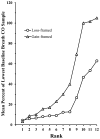The effect of framing incentives as either losses or gains with contingency management for smoking cessation
- PMID: 23403276
- PMCID: PMC3575603
- DOI: 10.1016/j.addbeh.2013.01.007
The effect of framing incentives as either losses or gains with contingency management for smoking cessation
Abstract
Cumulative prospect theory predicts that losses motivate behavior more than equal gains. Contingency management procedures effectively reduce drug use by placing incentives in direct competition with the drug taking behavior. Therefore, framing incentives as losses, rather than gains should decrease drug use to a greater extent, given equivalent incentives. We examined whether contingent vouchers described as either losses or gains differentially affected smoking abstinence rates. Over 5 consecutive days, participants could either gain $75 per day for verified abstinence or lose $75 per day (initial endowment=$375) for continuing to smoke. As a result, loss-framed participants were more likely to achieve at least one day of abstinence. There was a trend towards loss-framed participants reducing the amount smoked more than gain-framed participants. However, participants in the gain-framed group were more likely to maintain abstinence, once initiated. The results partially support cumulative prospect theory and suggest additional ways to initiate behavior change using incentives, outside of using larger magnitude incentives in contingency management procedures.
Copyright © 2013 Elsevier Ltd. All rights reserved.
Conflict of interest statement
Conflict of interest
All authors declare that they have no conflicts of interest.
Figures


References
-
- Akl EA, Oxman AD, Herrin J, Vist GE, Terrenato I, Sperati F, Costiniuk C, Blank D, Schuenemann Framing of health information messages. Cochrane Database of Systematic Reviews. 2011;12:CD006777. - PubMed
-
- Benowitz NL, Jacob P, Ahijevych K, Jarvis MF, Hall S, et al. Biochemical verification of tobacco use and cessation. Nicotine and Tobacco Research. 2002;4:149–159. - PubMed
-
- Detweiler JB, Bedell BT, Salovey BT, Pronin E, Rothman AJ. Message framing and sunscreen use: Gain-framed messages motivate beach-goers. Health Psychology. 1999;18:189–196. - PubMed
-
- Harinck F, Van Dijk E, Van Beest I, Mersmann P. When gains loom larger than losses. Psychological Science. 2007;18:1099–1105. - PubMed
-
- Higgins ST, Silverman K, Heil SH, editors. Contingency management in substance abuse. New York: Guilford Press; 2008.
Publication types
MeSH terms
Grants and funding
LinkOut - more resources
Full Text Sources
Other Literature Sources
Medical
Research Materials

